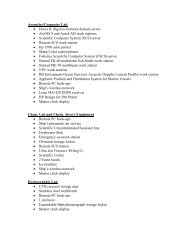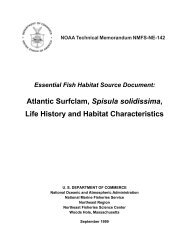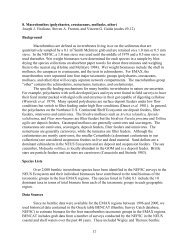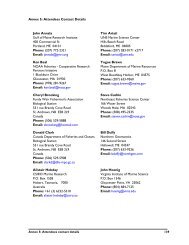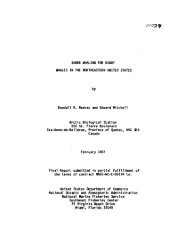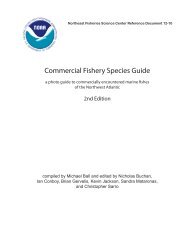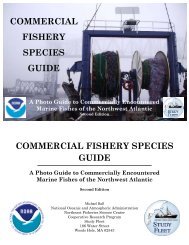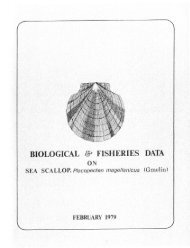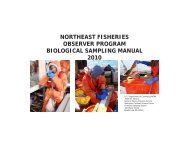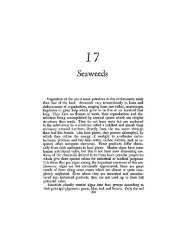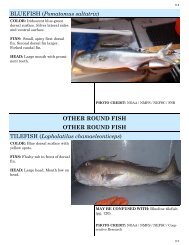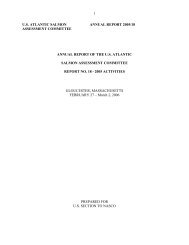Scup, Stenotomus chrysops, Life History and Habitat Characteristics
Scup, Stenotomus chrysops, Life History and Habitat Characteristics
Scup, Stenotomus chrysops, Life History and Habitat Characteristics
Create successful ePaper yourself
Turn your PDF publications into a flip-book with our unique Google optimized e-Paper software.
One of the greatest long-term threats to the viability of<br />
commercial <strong>and</strong> recreational fisheries is the continuing<br />
loss of marine, estuarine, <strong>and</strong> other aquatic habitats.<br />
Magnuson-Stevens Fishery Conservation <strong>and</strong><br />
Management Act (October 11, 1996)<br />
The long-term viability of living marine resources<br />
depends on protection of their habitat.<br />
NMFS Strategic Plan for Fisheries<br />
Research (February 1998)<br />
The Magnuson-Stevens Fishery Conservation <strong>and</strong><br />
Management Act (MSFCMA), which was reauthorized<br />
<strong>and</strong> amended by the Sustainable Fisheries Act (1996),<br />
requires the eight regional fishery management councils to<br />
describe <strong>and</strong> identify essential fish habitat (EFH) in their<br />
respective regions, to specify actions to conserve <strong>and</strong><br />
enhance that EFH, <strong>and</strong> to minimize the adverse effects of<br />
fishing on EFH. Congress defined EFH as “those waters<br />
<strong>and</strong> substrate necessary to fish for spawning, breeding,<br />
feeding or growth to maturity.” The MSFCMA requires<br />
NMFS to assist the regional fishery management councils<br />
in the implementation of EFH in their respective fishery<br />
management plans.<br />
NMFS has taken a broad view of habitat as the area<br />
used by fish throughout their life cycle. Fish use habitat<br />
for spawning, feeding, nursery, migration, <strong>and</strong> shelter, but<br />
most habitats provide only a subset of these functions.<br />
Fish may change habitats with changes in life history<br />
stage, seasonal <strong>and</strong> geographic distributions, abundance,<br />
<strong>and</strong> interactions with other species. The type of habitat,<br />
as well as its attributes <strong>and</strong> functions, are important for<br />
sustaining the production of managed species.<br />
The Northeast Fisheries Science Center compiled the<br />
available information on the distribution, abundance, <strong>and</strong><br />
habitat requirements for each of the species managed by<br />
the New Engl<strong>and</strong> <strong>and</strong> Mid-Atlantic Fishery Management<br />
Councils. That information is presented in this series of<br />
30 EFH species reports (plus one consolidated methods<br />
report). The EFH species reports comprise a survey of the<br />
important literature as well as original analyses of fishery-<br />
JAMES J. HOWARD MARINE SCIENCES LABORATORY<br />
HIGHLANDS, NEW JERSEY<br />
SEPTEMBER 1999<br />
FOREWORD<br />
Page iii<br />
independent data sets from NMFS <strong>and</strong> several coastal<br />
states. The species reports are also the source for the<br />
current EFH designations by the New Engl<strong>and</strong> <strong>and</strong> Mid-<br />
Atlantic Fishery Management Councils, <strong>and</strong> have<br />
underst<strong>and</strong>ably begun to be referred to as the “EFH source<br />
documents.”<br />
NMFS provided guidance to the regional fishery<br />
management councils for identifying <strong>and</strong> describing EFH<br />
of their managed species. Consistent with this guidance,<br />
the species reports present information on current <strong>and</strong><br />
historic stock sizes, geographic range, <strong>and</strong> the period <strong>and</strong><br />
location of major life history stages. The habitats of<br />
managed species are described by the physical, chemical,<br />
<strong>and</strong> biological components of the ecosystem where the<br />
species occur. Information on the habitat requirements is<br />
provided for each life history stage, <strong>and</strong> it includes, where<br />
available, habitat <strong>and</strong> environmental variables that control<br />
or limit distribution, abundance, growth, reproduction,<br />
mortality, <strong>and</strong> productivity.<br />
Identifying <strong>and</strong> describing EFH are the first steps in<br />
the process of protecting, conserving, <strong>and</strong> enhancing<br />
essential habitats of the managed species. Ultimately,<br />
NMFS, the regional fishery management councils, fishing<br />
participants, Federal <strong>and</strong> state agencies, <strong>and</strong> other<br />
organizations will have to cooperate to achieve the habitat<br />
goals established by the MSFCMA.<br />
A historical note: the EFH species reports effectively<br />
recommence a series of reports published by the NMFS<br />
S<strong>and</strong>y Hook (New Jersey) Laboratory (now formally<br />
known as the James J. Howard Marine Sciences<br />
Laboratory) from 1977 to 1982. These reports, which<br />
were formally labeled as S<strong>and</strong>y Hook Laboratory<br />
Technical Series Reports, but informally known as “S<strong>and</strong>y<br />
Hook Bluebooks,” summarized biological <strong>and</strong> fisheries<br />
data for 18 economically important species. The fact that<br />
the bluebooks continue to be used two decades after their<br />
publication persuaded us to make their successors – the 30<br />
EFH source documents – available to the public through<br />
publication in the NOAA Technical Memor<strong>and</strong>um NMFS-<br />
NE series.<br />
JEFFREY N. CROSS, CHIEF<br />
ECOSYSTEMS PROCESSES DIVISION<br />
NORTHEAST FISHERIES SCIENCE CENTER



